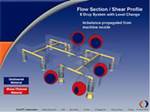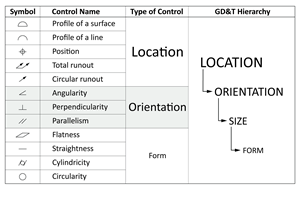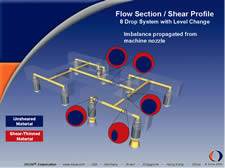Justification Through Data
Including position analysis in your data collection practices will help you make smarter maintenance and mold design decisions.
There are so many new technological options in mold design, building and processing that it can be con-fusing as to what new application should be used to improve what part of our business or exactly how it will affect a mold’s performance.
Justification
So how does a molder or manufacturer decide if the application of new technology will save their company dollars through increased and more reliable mold production or more, higher quality parts? How do they decide what is right for them and what is overkill? With a kinder, gentler four letter word: data.
Is It Really a Spade?
Any business surviving in this world today knows one thing for sure, bang for the buck is still big. Making an accurate assessment of how best to spend/invest your technology dollars must be directed by accurate, unbiased facts and figures, because once again you cannot improve a process that you can’t measure. What you perceive to be your most problematic mold performance or maintenance issue might not be, in an economic sense, the real issue.
A couple of the typical, more easily measured criteria to cost justify the decision to buy a new or invest in new technology:
- Keeping up with projected volume is normally the first indicator.
If you can’t keep up with yearly volume even with the mold running reliably around the clock, full cavitation at optimum cycle time, then it’s a no-brainer. But even then, it would be a mistake to run out and simply put in an order for another mold designed exactly like the one you have now. There hasn’t been a mold built that can’t be improved from either a performance or maintenance standpoint, and this fact should always be considered when purchasing new. - Radical change in product/part design.
Changes that occur, which will require a major redesign in tooling geometry across all cavities, will many times prompt the decision to go ahead and build new plates also. New plates plus new tooling equals a new mold. - Poor mold performance.
If the mold does not run full cavitation or cannot get through a typical production run without experiencing unscheduled breakdowns or mold pulls due to quality issues with parts or mold function, then a knee-jerk reaction might be made to replace the entire mold based on the boat anchor syndrome versus accurate mold data concerning repeating mold and part defects.
Drill Down
It is typical for a frustrated engineer or toolroom supervisor to throw up their hands and proclaim a mold is junk and needs to be replaced when upper management turns the heat up to make it run. Many times companies spend major dollars based more on the perceived issues than that of actual performance and maintenance (corrective action) costs.
When pressed for replacement justification details, most shops can present big picture costs like total dollars spent in tooling over a period of time and a few track labor costs for specific molds.
But before we react to this, we must be able to further breakdown those costs into specific issues concerning the type of unscheduled mold stops or downtime events, cavitation issues relating to identifiable mold or part defects and corrective actions to really understand if the issues are unmanageable or if the mold needs attention in only a couple of areas. A lack of data makes this last step impossible to know or to accurately justify, so the hands and blood pressure go up.
Data Utilization
As new technology changes/improves the way you mold parts, enhancing your data practices will drastically improve the way you troubleshoot and monitor all aspects of mold maintenance.
Position Is Everything
Some of the new technology today relates to a balanced mold fill. That is, every cavity should fill at exactly the same time or strange things can happen to the parts. Past articles by other authors in this magazine have covered a couple of ideas that help to improve/control this balance issue.
If asked as to whether or not a mold needs this new technology to perform better, the answer should be based on the frequency and pattern of specific defects occurring at specific positions in the mold that needs to be improved.
To make this call—and others that are based on performance or maintenance data—you need to track part/mold defects by mold position, not just cavity I.D.s that can change as tooling is replaced.
For instance if you have a 16-cavity mold, then each position, usually starting at the “zero” reference corner of the mold, gets numbered 1-16. As defects and maintenance gets tracked, you could begin to see patterns that point to areas or quadrants of molds that suggest that the mold fill is unbalanced, even if the runner or flow path through a hot runner is geometrically perfect.
Look at the sample defect position analysis report of a typical four-cavity mold in Chart 1. Each of the four positions is a different color. Many of the flashing defects (and by far the most affected position) are occurring in position #2 (red font).
This data makes you ask: Why do we flash this position the most? Does the flash always occur in the same direction in the same area or does it vary? Are we flashing here because we must pack out to keep position #4 from shorting? How is the water flow in this area?
And by simply sorting on the different columns (typical Excel tools), you also can relate the defects to press locations, shifts, mold configurations and other critical factors that cause repetitive problems.
Defect position analysis data will point to balance of fill issues, or other problems such as restricted cooling channels, inconsistent heaters, tooling stack problems, venting, alignment and other mold-related design or wear issues that normally will go undetected and lumped in with other problems, which helps to conceal the root cause.
Summary
Examine your data collection practices with an eye on raising the bar to include position analysis. It is a great troubleshooting tool that will unravel mold mysteries and lead you to the technology that you need to make smarter maintenance and mold design decisions.
| Defect position analysis report | ||||||||
| Mold | Description | Configuration | Press | TroubleShooters Defects | Type | Blocked/Noted | Position | Cavity ID |
| 67-17A | 4-Hole Wall Cap | 4-Hole | 09 | Flash Long Side Tab | Part | 2/11/03 | 01 | B1 |
| 67-17A | 4-Hole Wall Cap | 4-Hole | 09 | Dings/Drag on Part | Part | 2/22/03 | 01 | B1 |
| 67-17A | 4-Hole Wall Cap | 4-Hole | 09 | Flash Ejector Pin | Part | 2/27/03 | 01 | B1 |
| 67-17A | 4-Hole Wall Cap | 4-Hole | 09 | Flash Long Side Tab | Part | 2/27/03 | 01 | B1 |
| 67-17A | 4-Hole Wall Cap | 4-Hole | 18 | Flash Ejector Pin | Part | 5/28/03 | 01 | B1 |
| 67-17A | 4-Hole Wall Cap | 4-Hole | 08 | Burn on Part | Part | 4/16/04 | 01 | B1 |
| 67-17A | 4-Hole Wall Cap | 4-Hole | 09 | Flash Left Tab | Part | 2/11/03 | 02 | B2 |
| 67-17A | 4-Hole Wall Cap | 4-Hole | 09 | Flash Left Tab | Part | 2/14/03 | 02 | B2 |
| 67-17A | 4-Hole Wall Cap | 4-Hole | 09 | Flash Ejector Pin | Part | 2/15/03 | 02 | B2 |
| 67-17A | 4-Hole Wall Cap | 4-Hole | 09 | Flash Left Tab | Part | 2/21/03 | 02 | B2 |
| 67-17A | 4-Hole Wall Cap | 4-Hole | 09 | Flash Left Tab | Part | 2/22/03 | 02 | B2 |
| 67-17A | 4-Hole Wall Cap | 4-Hole | 09 | Flash Left Tab | Part | 2/23/03 | 02 | B2 |
| 67-17A | 4-Hole Wall Cap | 4-Hole | 09 | Flash Right Tab | Part | 2/27/03 | 02 | B2 |
| 67-17A | 4-Hole Wall Cap | 4-Hole | 09 | Flash Right Tab | Part | 2/27/03 | 02 | B2 |
| 67-17A | 4-Hole Wall Cap | 4-Hole | 09 | Flash Left Tab | Part | 2/27/03 | 02 | B2 |
| 67-17A | 4-Hole Wall Cap | 4-Hole | 09 | Flash Left Tab | Part | 2/27/03 | 02 | B2 |
| 67-17A | 4-Hole Wall Cap | 4-Hole | 18 | Flash Long Side Tab | Part | 5/23/03 | 02 | B2 |
| 67-17A | 4-Hole Wall Cap | 4-Hole | 18 | Flash Left Tab | Part | 5/28/03 | 02 | B2 |
| 67-17A | 4-Hole Wall Cap | 4-Hole | 09 | Flash Left Tab | Part | 7/29/03 | 02 | B2 |
| 67-17A | 4-Hole Wall Cap | 4-Hole | 18 | Flash Ejector Pin | Part | 9/26/03 | 02 | B2 |
| 67-17A | 4-Hole Wall Cap | 4-Hole | 18 | Flash Ejector Pin | Part | 12/12/03 | 02 | B2 |
| 67-17A | 4-Hole Wall Cap | 4-Hole | 18 | Black Streaks | Mold | 4/12/04 | 02 | B2 |
| 67-17A | 4-Hole Wall Cap | 4-Hole | 09 | Flash Left Tab | Part | 4/16/04 | 02 | B2 |
| 67-17A | 4-Hole Wall Cap | 4-Hole | 09 | Burn on Part | Part | 4/16/04 | 02 | B2 |
| 67-17A | 4-Hole Wall Cap | 4-Hole | 09 | Black Streaks | Mold | 4/16/04 | 02 | B2 |
| 67-17A | 4-Hole Wall Cap | 4-Hole | 09 | Flash Left Tab | Part | 4/18/04 | 02 | B2 |
| 67-17A | 4-Hole Wall Cap | 4-Hole | 09 | Flash Long Side Tab | Part | 4/27/04 | 02 | B2 |
| 67-17A | 4-Hole Wall Cap | 4-Hole | 09 | Flash Left Tab | Part | 4/27/04 | 02 | B2 |
| 67-17A | 4-Hole Wall Cap | 4-Hole | 09 | Flash Left Tab | Part | 1/7/03 | 03 | B3 |
| 67-17A | 4-Hole Wall Cap | 4-Hole | 09 | Flash Right Tab | Part | 2/11/03 | 03 | B3 |
| 67-17A | 4-Hole Wall Cap | 4-Hole | 09 | Flash Right Tab | Part | 2/11/03 | 03 | B3 |
| 67-17A | 4-Hole Wall Cap | 4-Hole | 09 | Flash Right Tab | Part | 2/14/03 | 03 | B3 |
| 67-17A | 4-Hole Wall Cap | 4-Hole | 09 | Flash Right Tab | Part | 2/15/03 | 03 | B3 |
| 67-17A | 4-Hole Wall Cap | 4-Hole | 09 | Flash Ejector Pin | Part | 2/27/03 | 03 | B3 |
| 67-17A | 4-Hole Wall Cap | 4-Hole | 09 | Flash Long Side Tab | Part | 2/27/03 | 03 | B3 |
| 67-17A | 4-Hole Wall Cap | 4-Hole | 18 | Flash Ejector Pin | Part | 5/28/03 | 03 | B3 |
| 67-17A | 4-Hole Wall Cap | 4-Hole | 18 | Flash Ejector Pin | Part | 12/12/03 | 03 | B3 |
| 67-17A | 4-Hole Wall Cap | 4-Hole | 18 | Black Streaks | Mold | 4/12/04 | 03 | B3 |
| 67-17A | 4-Hole Wall Cap | 4-Hole | 08 | Black Streaks | Mold | 4/16/04 | 03 | B3 |
| 67-17A | 4-Hole Wall Cap | 4-Hole | 18 | Flash Left Tab | Part | 11/29/04 | 03 | B3 |
| 67-17A | 4-Hole Wall Cap | 4-Hole | 09 | Flash Long Side Tab | Part | 2/11/03 | 04 | B4 |
| 67-17A | 4-Hole Wall Cap | 4-Hole | 09 | Flash Right Tab | Part | 2/14/03 | 04 | B4 |
| 67-17A | 4-Hole Wall Cap | 4-Hole | 09 | Flash Right Tab | Part | 2/15/03 | 04 | B4 |
| 67-17A | 4-Hole Wall Cap | 4-Hole | 09 | Flash Right Tab | Part | 2/16/03 | 04 | B4 |
| 67-17A | 4-Hole Wall Cap | 4-Hole | 09 | Burn on Part | Part | 2/25/03 | 04 | B4 |
| 67-17A | 4-Hole Wall Cap | 4-Hole | 09 | Burn on Part | Part | 2/27/03 | 04 | B4 |
| 67-17A | 4-Hole Wall Cap | 4-Hole | 09 | Flash Ejector Pin | Part | 2/27/03 | 04 | B4 |
| 67-17A | 4-Hole Wall Cap | 4-Hole | 09 | Flash Long Side Tab | Part | 2/27/03 | 04 | B4 |
| 67-17A | 4-Hole Wall Cap | 4-Hole | 09 | Flash Left Tab | Part | 2/27/03 | 04 | B4 |
| 67-17A | 4-Hole Wall Cap | 4-Hole | 09 | Flash Right Tab | Part | 2/27/03 | 04 | B4 |
| 67-17A | 4-Hole Wall Cap | 4-Hole | 18 | Flash Ejector Pin | Part | 5/28/03 | 04 | B4 |
| 67-17A | 4-Hole Wall Cap | 4-Hole | 09 | Dings/Drag on Part | Part | 8/4/03 | 04 | B4 |
Related Content
Leading Mold Manufacturers Share Best Practices for Improving Efficiency
Precise Tooling Solutions, X-Cell Tool and Mold, M&M Tool and Mold, Ameritech Die & Mold, and Cavalier Tool & Manufacturing, sit down for a fast-paced Q&A focused on strategies for improving efficiencies across their operations.
Read MoreHow to Automate Process and Design
Moldmakers can improve their operations and stop wasting time by taking these six steps for process and design automation.
Read MoreHow to Select a Mold Temperature Controller
White paper shares how cooling channel analysis, which collects maximum pressure drop, total flow rate and heat dissipation, eases the performance evaluation of mold temperature controllers.
Read MoreTolerancing in Mold Design, Part 2: Using GD&T to Address Conventional Tolerancing Issues
Mold designers can achieve a single interpretation of workpiece functionality when following the American Society of Mechanical Engineers Geometric Dimensioning and Tolerancing standard.
Read MoreRead Next
Part Two of a Two-Part Series Valve Gate Sequencing Strategies
More valve gate strategies and how they help moldmakers and molders work together to develop a mold that will provide the most consistent performance.
Read MoreImproving Shear-Induced Imbalance in Hot Runner Systems
Even melt distribution and balanced filling to and across all cavities while avoiding restrictive mixers is possible with hot runner manifold construction that incorporates a melt rotation design.
Read MorePart One of a Two-Part Series Valve Gate Sequencing Strategies
Ways to use valve gate control strategies to improve quality, efficiency and profitability
Read More







.jpg;maxWidth=300;quality=90)




















